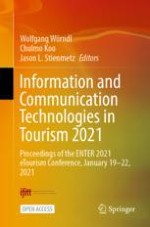1 Introduction
2 Literature Review
2.1 Perceived Risk
2.2 Virtual Reality (VR)
2.3 Applications of VR in Tourism
2.4 Technology Acceptance Model (TAM)
3 Hypothesis Development
4 Methodology
4.1 Data Analysis
5 Results
Constructs | Construct reliability α | AVE |
|---|---|---|
Perceived risk | 0.79 | 0.49 |
Perceived severity | 0.82 | 0.61 |
Presence | 0.90 | 0.50 |
Perceived usefulness | 0.72 | 0.47 |
Perceived ease of use | 0.76 | 0.53 |
Behavioral intention | 0.81 | 0.52 |
Index | Criteria | Indicators |
|---|---|---|
χ2 | p > 0.05 | 332.474 (p < 0.00) |
χ2/df | <5 | 1.21 |
Fit indices | ||
GFI | >0.90 | 0.89 |
AGFI | >0.90 | 0.85 |
CFI | >0.95 | 0.97 |
RMSEA | <0.08 | 0.03 |
TLI | <0.90 | 0.97 |
Path | Coefficient of determination | S.E. | Result |
|---|---|---|---|
H1: PEU → BI | 0.23 | 0.14 | Reject |
H2: PU → BI | 1.28 | 0.21 | Support |
H3: PEU → PU | 0.57 | 0.13 | Support |
H4: RISK → PU | −0.00 | 0.04 | Reject |
H5: SEV → PU | 0.26 | 0.07 | Support |
H6: PR → PU | 0.33 | 0.07 | Support |
